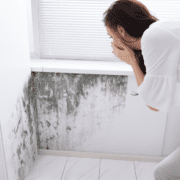Does my house have indoor mold?
To put it quite simply, every house has indoor mold. Yeah, I said it. Mold is in every house on the planet. There are settled spores on the surfaces we touch and in the air we breathe. In nature, the job of mold is to get rid of and consume dead matter. Ever wonder where all the dead leaves go? That’s right, mold and other organisms consumed them.
Mold is a naturally occurring family of fungi- just like mushrooms. Think of mold as similar to a plant; it has roots, branches, and seeds. The roots and branches (hyphae) are responsible for collecting and transporting nutrients. Once the hyphae are actually visible (think a spot of mold on a piece of bread) they are called mycelium. Spores act like the seeds; they are carried from the mycelium to new places by animals and the wind to start new mold colonies.
Like all plants, mold requires moisture to grow. Most molds will only grow where water already exists, but some molds will actively search out moisture if there is none around and will use rhizomorphs to pipe it back to home like a big straw.
The key to controlling any indoor mold problem is to control the moisture. If you have an indoor mold problem, then you also have a water problem. It may be a leak coming from plumbing or an appliance, condensation buildup on walls and windows from indoor humidity being too high, or water intrusion where water has come into the house somehow from the outside.
Once you find and repair the moisture problem, it’s then time to clean up the mold. If the affected area is less than about 10 square feet, then you could probably handle the cleanup yourself. Mold remediation is typically carried out by either removing the material the mold is on or cleaning the mold off with a cleaner called Botanical HP. For mold issues that are more than 10 square feet I recommend the use of a professional mold remediation company. Remediation can be a very involved process at times and it’s worth it to do it right the first time.
After everything is fixed and returned to normal you should have a company certified in mold testing and inspection examine the affected area a couple weeks later to make sure the remediation was effective.
What if I have toxic mold?
My question to you is how do you know its toxic mold? It’s impossible to look at mold and tell if it’s toxic or not, I don’t even care if the mold is black. There are more than 350,000 different types of mold in the world and they come in every color of the rainbow. The only way to know for sure what type of mold you have is to have a certified mold inspection and testing company collect a sample of the mold and take it to a lab for definitive analysis.
That being said, some individuals can be sensitive to mold and the mycotoxin it may be producing, only a medical professional will be able to make that determination. It is important to note that not all species of mold are known to produce mycotoxins.
The mold that is typically singled out as “toxic black mold” is called stachybotrys. Stachybotrys loves to grow on things with a high cellulose content like drywall, paper, and fiberboard. It is also almost always associated with water damage to a home. It is known to produce a mycotoxin that is potentially harmful to humans. Again, the only way to confirm or deny the presence of this particular type of mold is to have it analyzed by a laboratory.
If you have any questions about mold issues or know someone who may need some help, please don’t hesitate to reach out.



Mold can compromise and weaken the immune system, especially if you are exposed to the mold spores. This mainly happens to people with asthma and allergies. Professional mold remediation can help improve the health of your family and even your pets by completely removing mold from your home.